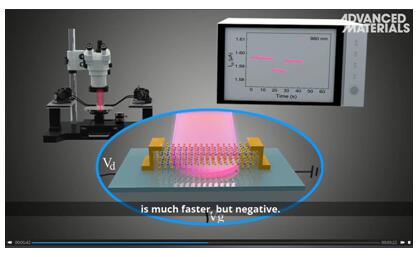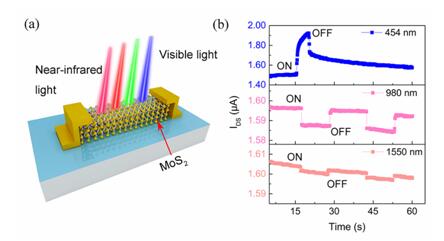


Recently, the team leading by Prof. Zhang Tong of School of Electronic Science and Engineering of Southeast University has made a significant progress on two-dimensional material photoelectric detector. On January 8 the research results were published in the top journal of materials research Advanced Materials. The article is titled “Broadband MoS2 Field-Effect Phototransistors:Ultrasensitive Visible-Light Photoresponse and NegativeInfrared Photoresponse”. On January 31 due to the recommendation of editor a video abstract of the article was released on official website of Advanced Materials, and other video website such as YouTube.
Inverse photoresponse is discovered from phototransistors based on molybdenum disulfide (MoS2). The devices are capable of detecting photons with energy below the bandgap of MoS2. Under the illumination of near-infrared (NIR) light at 980 and 1550 nm, negative photoresponses with short response time (50 ms) are observed for the first time. Upon visible-light illumination, the phototransistors exhibit positive photoresponse with ultrahigh responsivity on the order of 104–105 A W−1 owing to the photogating effect and charge trapping mechanism. Besides, the phototransistors can detect a weak visible-light signal with effective optical power as low as 17 picowatts (pW). A thermally induced photoresponse mechanism, the bolometric effect, is proposed as the cause of the negative photocurrent in the NIR regime. The thermal energy of the NIR radiation is transferred to the MoS2 crystal lattice, inducing lattice heating and resistance increase. This model is experimentally confirmed by low-temperature electrical measurements. The bolometric coefficient calculated from the measured transport current change with temperature is −33 nA K−1. These findings offer a new approach to develop sub-bandgap photodetectors and other novel optoelectronic devices based on 2D layered materials.
The first author of the article is doctoral student Wu Jingyuan of School of Electronic Science and Engineering of SEU. The corresponding authors are Prof. Zhang Tong and Prof. Daping Chu of University of Cambridge.
Since 2010, the team leading by Prof Zhang Tong has made important achievements on nano thin-film optical components, surface plasmon, printed electronics, micro-nano integration and inertial sensor. The team has published articles on international frontier journals including Energy & Environmental Science, ACS Nano, ACS Applied Materials & InterfacesandNanoscale. The team has four United States patents, and published four academic monographies. The work is funded by Ministry of science and Technology, National Natural Science Foundation, and Scientific Research Foundation of Graduate School of Southeast University.
















